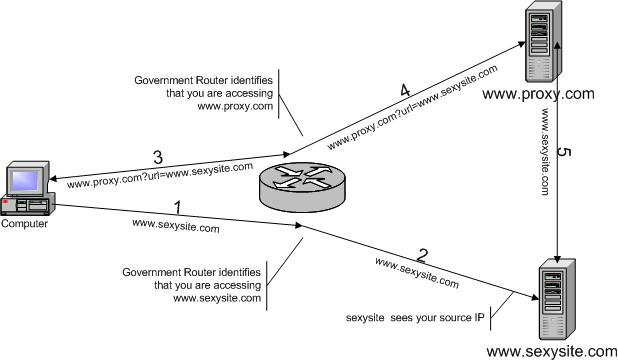Why do people need proxies
Anonymity
In this scenario, a user wants to remain anonymous to the website they are visiting. When a user visits a site, details such as your IP, what browser you are using, etc., are available to the site. Using this information, the site is usually able to keep track of you. Using a proxy prevents this as the site you are visiting sees the proxy as the end-user, effectively hiding your IP.
Security
If users are afraid that somebody is keeping track of the sites they are visiting via routers and firewalls, then a proxy will go some way to stopping that. These web proxies usually encode the URLs, so firewalls and routers have no idea what site the user is visiting.
Access
The most common use of web proxies is to get around firewalls and blocks. Social networking sites such as Facebook and Myspace etc. are usually considered detrimental to productivity and are banned from work and school networks. These firewall rules are usually based on IPs and hostnames and are easily overcome by web proxies that rewrite these URLs.
Learn about the Different Types of Proxies
Web proxies come in many guises, but all perform essentially the same set of functions. Proxies fall into two basic categories web proxies and IP: port proxies.
Web Proxies
Web proxies are the most prolific and popular kind of proxy on the net today. These are suffix-based proxies which are colloquially referred to as web-based proxies or web proxies. These proxies do not require any changes to browser settings and are commonly used to bypass firewalls. Their ease of use makes them popular.
IP: Port Proxies
IP: Port proxies refer to ‘real proxies.’ These are referred to as Open Proxies, Elite Proxies and High-Anonymity Proxies. These proxies require your browser’s proxy settings to be changed. In addition to being used for bypassing firewalls and protecting your identity, these proxies are heavily used for SEO work such as comment posting and URL harvesting.
Proxy Networks
Proxy networks consist of modified versions of the aforementioned IP: port proxies. The idea of a proxy network is for a request to be forwarded many times between lots of proxies so that it makes it much harder to trace the request. Proxy networks are usually used by hardcore hackers and developers and are not for the faint-hearted. CODEEN and TOR are the more famous of the networks.
How Proxies Work
Let us now take a look at how these proxies work. How they get around firewalls and how they anonymize requests.
Access
First, let us see how proxies allow us to go through firewalls and bypass bans. Let us assume that you want to access a site called www.sexysite.com. But your network administrator has blocked this site.

- When you try to access www.sexysite.com from your browser, the request first goes to the firewall. The firewall sees that you are trying to access www.sexysite.com and blocks it because it is a banned site.
- When you go through the proxy, the firewall sees www.proxy.com. As this is not a banned site, the firewall allows it.
- Once the request reaches www.proxy.com, the proxy will fetch the data from www.sexysite.com and return it. All this time, the firewall thinks you have made a request to http://www.proxy.com.
Anonymity
Now let us look at how proxies protect your anonymity. Let us assume again that you want to visit www.sexysite.com, but you don want anyone to know about it.

- When you try to access www.sexysite.com from your browser, the request goes through an ISP router. This router will detect what site you are visiting and store the information.
- The site www.sexysite.com will then be able to detect your location through your source IP. Therefore both the site and the government know what you are doing.
- When you access www.sexysite.com through your proxy, the router sees a request to www.proxy.com. The router does not know that you are accessing www.sexysite.com.
- The request goes to the proxy.
- Then the proxy makes a request to www.sexysite.com. The site then sees the proxies source IP. Your original source IP is not available. This way, the URL you are visiting and your source IP are kept hidden.
What type of proxy should I use?
The type of proxy you should use depends primarily on security. Also, you must remember that with any proxy, you may have visibility of the usernames and passwords you submit. Under no means are you to do any kind of banking or financial transaction through a proxy unless the proxy is yours or you can trust it completely.
The bigger the tick, the better suited the proxy

As a general rule of thumb, for most surfing, try and use an IP: port proxy first. If for some reason you cannot, because you’re using a LAN that already requires a proxy, then try a web proxy. Proxy networks such as CODEEN and TOR should only be used with extreme care under special circumstances.
How to Find Proxies
How do you find a proxy? The easy answer would be to search for free web proxies in Google, and you will get millions of sites. These apply to all kinds of proxies, web proxies, and IP: port proxies.
Free Proxies
Searching for free proxies is easy. Just type in “free web proxy” in Google, and you will get millions of sites. To find Ip: port proxies, just type in “free IP port proxies” in google, and you will get sites with lists of IP: port proxies. The next step is trial and error. Try the many different proxies until you find one that makes you happy.
Free Proxy Lists
Most of these sites will have lists of web proxies or IP: port proxies that are rated according to uptime or speed. Proxy owners usually have to pay to get onto these lists. The downside of this is that these lists are rated according to who paid the most and not necessarily according to the best and fastest proxies. These sites are notorious for inaccurate results, and you will find that most proxies listed on these sites are interminably slow or don稚 quite work with the sites you are interested in.
Paid Proxy Lists
Just like Free Proxy Lists. The only difference is you have to pay for them. These lists are usually compiled by searching free proxy lists and picking out the best proxies. We recommend not wasting money on something you can get for free.
Paid Proxies
You get paid web proxies and paid IP: port proxies. These paid proxies are usually much faster than free ones. They won’t have annoying advertisements and popup boxes. They are generally more secure and offer a better overall user experience. We recommend DirtCheapProxies.com for cheap, fast, secure, and reliable IP: port proxies.
Running your own proxy.
What do people get out of hosting these proxies? Surely they are not doing it as a service to the public. Most proxy owners wish to make money from their proxies. There are a couple of ways of doing this. But the two generally accepted ways. The first is to sell advertising space on your proxy index page and proxified pages. The second is to sell your proxy. To make money from a proxy, you first need a proxy.
Setting up a Web Proxy
Setting up a web proxy is relatively easy. There are many free web proxy scripts out there and tons of support on thousands of forums. The most popular scripts are given below.
- PHProxy
- Glype Proxy
- Zelune and Phphatom
- Surrogaffier, the link is at the bottom of the page
About 99.9% of the web proxies on the net today are some incarnation of one of the above. You can download the scripts and install them on any shared hosting provider, and you are good to go.
Setting up an IP: Port Proxy
The most popular open-source versions of these proxies are Apache’s mod_proxy and Squid proxy. These require a Virtual Private or Virtual Dedicated server and cannot be run on shared hosting. This means that you will need an in-depth knowledge of Unix/Apache/Squid to get these running.
There is, however, an open-source Php-based Ip: Proxy emulator that will run in shared hosting. This behaves like an IP: Port proxy but is actually a simple PHP script that will run in any hosting provider that supports PHP.
projectmugatiya.blogspot.com
Proxy Hosting
Once you have downloaded a proxy, you need a place to host it. You can usually find cheap hosting that costs less than $10 a month with around 500 GB bandwidth. Some hosting providers do not allow proxies because they use a lot of CPU. Some hosting providers, such as xproxyhost.com, have special proxy plans. What you essentially need is PHP support, and 99.9% of the hosting providers support PHP.
While most hosting providers have sufficient bandwidth for web proxies, Ip: port proxies will need much, much more. As a rule of thumb, an IP: Port proxy running about 32 Apache clients (MaxClients) will need about 30-50GB of bandwidth a day.
Monetizing your Proxy
The fastest way to monetize a proxy is to use an affiliate program to display ads on your index page and on your proxified pages. The 800-pound gorilla in this area is Google Adsense. You can insert Adsense on your home page or start-up page, but it is usually not a good idea to insert Adsense on proxified pages. Proxified pages are the pages you are proxying, such as Facebook, etc. This is because you cannot control what sites users go to, and some of those sites may violate Google’s terms of service. This will lead to Google banning ads to your domain.
There many other Adsense alternatives such as AdBrite, Bidvertiser, Clicksor and AdultFriendFinder. It is up to the individual user to try them out and see what works best. It is generally accepted that Google痴 Adsense is the most favored. The consensus amongst proxy owners is to use Adsense on your main page or start-up page and to use another less stringent affiliate such as Adbrite on the proxified pages.
The final way to make money from your proxy is, of course, to sell it. As a rule of thumb, the cost of a site is usually how much you can earn from it in 3 months. So if your site earns about $10 a day, then the cost of that site would be about 3 x 30 x 10, about $900, plus the cost of your domain. But the truth is that a PR2 (page rank) proxy site will retail for close to $100. There are many forums on the web where you can find buyers and sellers for proxies.
Running Your Proxy
There are some important things to note when running a proxy. Some of them are listed below.
Finite Proxy Life
A lot of people believe that it is best to sell off a proxy after a certain amount of time. They believe that once your proxy is well established, it will be blocked by network administrators and so will start to lose traffic. By the time you reach the
Ads on Proxified Pages
Some affiliates, such as Adsense, read the text on the pages they are displayed. In this, an affiliate such as Google will read the HTML on the proxified pages. If the pages have adult or violent content, Google Adsense will register it as adult or violent content and stop serving ads to that IP. The IP is the proxies IP. Also, note that it is not a wise idea to use AdSense on IP: port proxies such as on “Project Mugatiya.”
Phishing
This is a very interesting aspect of web proxies. What happens is a user navigates to a famous site such as eBay or Paypal. The user then copies the URL in the browser address bar, pastes it in an email, and sends it to the eBay or Paypal complaints mail address stating that the site is a phishing site. The problem is that the URL points to your proxy, but it looks like the eBay or Paypal site. This constitutes a phishing attack, and eBay or PayPal will then get in touch with your hosting provider. IP: port proxies do not have this issue.
Spamming/DDOS
This mostly befalls IP: port proxies but can sometimes fall on web proxies too. This is where your proxy is used for comment spam or a Distributed Denial of Service DDoS attack. Because the server on the receiving end of the attack sees your proxy IP, your IP will be blacklisted, and the site under attack will most certainly notify your hosting provider of the origin. The only way to guard against this is to have Turing Tests (Captchas) and scripts that check the logs for repetitive behavior and block the requesting IPs.


